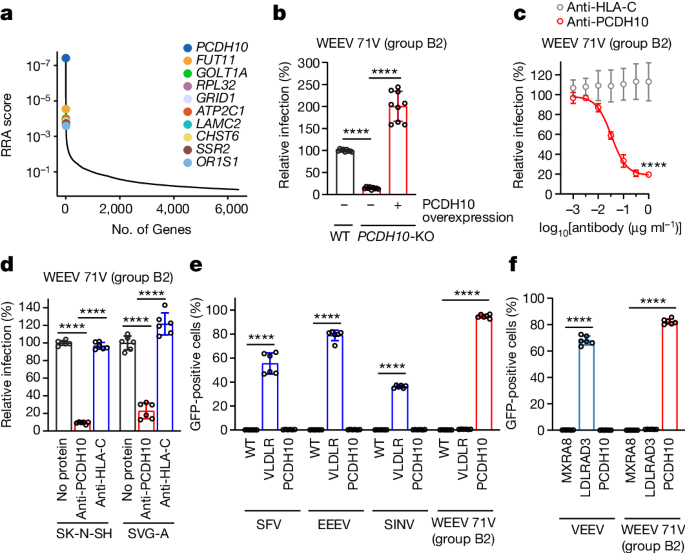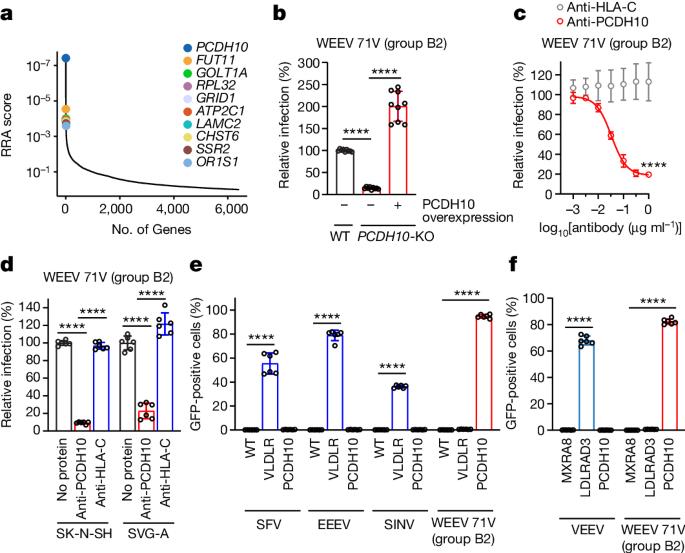Shifts in receptors during submergence of an encephalitic arbovirus
IF 50.5
1区 综合性期刊
Q1 MULTIDISCIPLINARY SCIENCES
引用次数: 0
Abstract
Western equine encephalitis virus (WEEV) is an arthropod-borne virus (arbovirus) that frequently caused major outbreaks of encephalitis in humans and horses in the early twentieth century, but the frequency of outbreaks has since decreased markedly, and strains of this alphavirus isolated in the past two decades are less virulent in mammals than strains isolated in the 1930s and 1940s1–3. The basis for this phenotypic change in WEEV strains and coincident decrease in epizootic activity (known as viral submergence3) is unclear, as is the possibility of re-emergence of highly virulent strains. Here we identify protocadherin 10 (PCDH10) as a cellular receptor for WEEV. We show that multiple highly virulent ancestral WEEV strains isolated in the 1930s and 1940s, in addition to binding human PCDH10, could also bind very low-density lipoprotein receptor (VLDLR) and apolipoprotein E receptor 2 (ApoER2), which are recognized by another encephalitic alphavirus as receptors4. However, whereas most of the WEEV strains that we examined bind to PCDH10, a contemporary strain has lost the ability to recognize mammalian PCDH10 while retaining the ability to bind avian receptors, suggesting WEEV adaptation to a main reservoir host during enzootic circulation. PCDH10 supports WEEV E2–E1 glycoprotein-mediated infection of primary mouse cortical neurons, and administration of a soluble form of PCDH10 protects mice from lethal WEEV challenge. Our results have implications for the development of medical countermeasures and for risk assessment for re-emerging WEEV strains. Knockout studies using CRISPR–Cas9 identify PCDH10 as a selective host cellular receptor for western equine encephalitis virus.


脑炎虫媒病毒潜伏过程中受体的变化。
西方马脑炎病毒(WEEV)是一种节肢动物传播的病毒(虫媒病毒),在二十世纪初经常在人类和马匹中引起大规模的脑炎暴发,但暴发的频率后来明显降低,而且在过去二十年中分离出的这种α病毒毒株对哺乳动物的毒力比二十世纪三十年代和四十年代分离出的毒株要弱1-3。WEEV 株系的这种表型变化以及同时出现的疫情活动下降(称为病毒潜伏3)的基础尚不清楚,高毒力株系重新出现的可能性也不清楚。在这里,我们发现原粘连蛋白 10 (PCDH10) 是 WEEV 的细胞受体。我们的研究表明,20 世纪 30 年代和 40 年代分离出的多株高致病性祖先 WEEV 株系除了能与人类 PCDH10 结合外,还能与极低密度脂蛋白受体(VLDLR)和载脂蛋白 E 受体 2(ApoER2)结合。然而,我们研究的大多数 WEEV 株系都能与 PCDH10 结合,而当代的一个株系却失去了识别哺乳动物 PCDH10 的能力,但却保留了与禽类受体结合的能力,这表明 WEEV 在流行循环过程中适应了主要的贮存宿主。PCDH10 支持 WEEV E2-E1 糖蛋白介导的小鼠皮层神经元原代感染,服用可溶性 PCDH10 可保护小鼠免受致命的 WEEV 挑战。我们的研究结果对医疗对策的开发和WEEV毒株再次出现的风险评估具有重要意义。
本文章由计算机程序翻译,如有差异,请以英文原文为准。
求助全文
约1分钟内获得全文
求助全文
来源期刊

Nature
综合性期刊-综合性期刊
CiteScore
90.00
自引率
1.20%
发文量
3652
审稿时长
3 months
期刊介绍:
Nature is a prestigious international journal that publishes peer-reviewed research in various scientific and technological fields. The selection of articles is based on criteria such as originality, importance, interdisciplinary relevance, timeliness, accessibility, elegance, and surprising conclusions. In addition to showcasing significant scientific advances, Nature delivers rapid, authoritative, insightful news, and interpretation of current and upcoming trends impacting science, scientists, and the broader public. The journal serves a dual purpose: firstly, to promptly share noteworthy scientific advances and foster discussions among scientists, and secondly, to ensure the swift dissemination of scientific results globally, emphasizing their significance for knowledge, culture, and daily life.
 求助内容:
求助内容: 应助结果提醒方式:
应助结果提醒方式:


